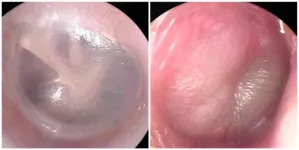(Press-News.org) A new cellphone app developed by physician-scientists at UPMC and the University of Pittsburgh, which uses artificial intelligence (AI) to accurately diagnose ear infections, or acute otitis media (AOM), could help decrease unnecessary antibiotic use in young children, according to new research published today in JAMA Pediatrics.
AOM is one of the most common childhood infections for which antibiotics are prescribed but can be difficult to discern from other ear conditions without intensive training. The new AI tool, which makes a diagnosis by assessing a short video of the ear drum captured by an otoscope connected to a cellphone camera, offers a simple and effective solution that could be more accurate than trained clinicians.
“Acute otitis media is often incorrectly diagnosed,” said senior author Alejandro Hoberman, M.D., professor of pediatrics and director of the Division of General Academic Pediatrics at Pitt’s School of Medicine and president of UPMC Children’s Community Pediatrics. “Underdiagnosis results in inadequate care and overdiagnosis results in unnecessary antibiotic treatment, which can compromise the effectiveness of currently available antibiotics. Our tool helps get the correct diagnosis and guide the right treatment.”
According to Hoberman, about 70% of children have an ear infection before their first birthday. Although this condition is common, accurate diagnosis of AOM requires a trained eye to detect subtle visual findings gained from a brief view of the ear drum on a wriggly baby. AOM is often confused with otitis media with effusion, or fluid behind the ear, a condition that generally does not involve bacteria and does not benefit from antimicrobial treatment.
To develop a practical tool to improve accuracy in the diagnosis of AOM, Hoberman and his team started by building and annotating a training library of 1,151 videos of the tympanic membrane from 635 children who visited outpatient UPMC pediatric offices between 2018 and 2023. Two trained experts with extensive experience in AOM research reviewed the videos and made a diagnosis of AOM or not AOM.
“The ear drum, or tympanic membrane, is a thin, flat piece of tissue that stretches across the ear canal,” said Hoberman. “In AOM, the ear drum bulges like a bagel, leaving a central area of depression that resembles a bagel hole. In contrast, in children with otitis media with effusion, no bulging of the tympanic membrane is present.”
The researchers used 921 videos from the training library to teach two different AI models to detect AOM by looking at features of the tympanic membrane, including shape, position, color and translucency. Then they used the remaining 230 videos to test how the models performed.
Both models were highly accurate, producing sensitivity and specificity values of greater than 93%, meaning that they had low rates of false negatives and false positives. According to Hoberman, previous studies of clinicians have reported diagnostic accuracy of AOM ranging from 30% to 84%, depending on type of health care provider, level of training and age of the children being examined.
“These findings suggest that our tool is more accurate than many clinicians,” said Hoberman. “It could be a gamechanger in primary health care settings to support clinicians in stringently diagnosing AOM and guiding treatment decisions.”
“Another benefit of our tool is that the videos we capture can be stored in a patient’s medical record and shared with other providers,” said Hoberman. “We can also show parents and trainees — medical students and residents — what we see and explain why we are or are not making a diagnosis of ear infection. It is important as a teaching tool and for reassuring parents that their child is receiving appropriate treatment.”
Hoberman hopes that their technology could soon be implemented widely across health care provider offices to enhance accurate diagnosis of AOM and support treatment decisions.
Other authors on the study were Nader Shaikh, M.D., Shannon Conway, Timothy Shope, M.D., Mary Ann Haralam, C.R.N.P., Catherine Campese, C.R.N.P., and Matthew Lee, all of UPMC and the University of Pittsburgh; Jelena Kovačević, Ph.D., of New York University; Filipe Condessa, Ph.D., of Bosch Center for Artificial Intelligence; and Tomas Larsson, M.Sc, and Zafer Cavdar, both of Dcipher Analytics.
This research was supported by the Department of Pediatrics at the University of Pittsburgh School of Medicine.
END
New AI smartphone tool accurately diagnoses ear infections
2024-03-04
ELSE PRESS RELEASES FROM THIS DATE:
Screen time and parent-child talk when children are ages 12 to 36 months
2024-03-04
About The Study: This study found a negative association between screen time and measures of parent-child talk when children are 12 to 36 months of age. For every additional minute of screen time, children heard fewer adult words, spoke fewer vocalizations, and engaged in fewer back-and-forth interactions. Interventions aiming to promote early use of language should include support to manage screen time.
Authors: Mary E. Brushe, Ph.D., of the University of Western Australia in Adelaide, South Australia, Australia, is the corresponding author.
To access the embargoed study: Visit our For The Media website at this link https://media.jamanetwork.com/
(doi:10.1001/jamapediatrics.2023.6790)
Editor’s ...
Firearm access and gun violence exposure among American Indian or Alaska native and Black adults
2024-03-04
About The Study: In this nationally representative survey study of 3,542 American Indian or Alaska Native and Black U.S. adults, a substantial percentage of both groups reported living in homes with firearms, storing firearms loaded and unlocked, frequently carrying firearms outside the home, and having been exposed directly and indirectly to gun violence. These findings underscore the need for nuanced public health campaigns and policies and highlight challenges for law enforcement in contexts of racial disparities ...
Associations of medical debt with health status, premature death, and mortality in the US
2024-03-04
About The Study: The findings of this study of 2,943 counties suggest that medical debt is associated with worse health status, more premature deaths, and higher mortality rates at the county level in the U.S. Therefore, policies increasing access to affordable health care, such as expanding health insurance coverage, may improve population health.
Authors: Xuesong Han, Ph.D., of the American Cancer Society in Atlanta, is the corresponding author.
To access the embargoed ...
Low-cost liquid tames tooth decay
2024-03-04
An inexpensive, cavity-fighting liquid called silver diamine fluoride (SDF) works as well as dental sealants to keep tooth decay at bay in a school cavity prevention and treatment program, according to a new study by researchers at NYU College of Dentistry.
The study, which followed more than 4,000 elementary school students for four years and is published in JAMA Pediatrics, shows that SDF is an effective alternative to sealants, and can increase access to dental care while reducing costs.
Dental cavities are the most prevalent ...
More than 1/3 illicit drugs sold on the dark web contain unexpected substances
2024-03-04
Testing of illicit drugs bought online found 35% were not what they said they were, highlighting the urgent need for more local drug testing facilities in Australia to prevent harm and overdose.
The RMIT-led study analysed 103 illicit drug samples sourced from the now-defunct dark web forum Test4Pay in collaboration with the Australian National University, UNSW Sydney and Canadian testing facility Get Your Drugs Tested.
While 65% of samples contained only the advertised substance, the study found 14% of samples had a mixture ...
A better way to deliver fetal therapy for serious genetic disorders
2024-03-04
In a discovery that opens the door to a less invasive way of treating some serious disorders before birth, UC San Francisco scientists have found that delivering medicine through amniotic fluid is as effective as delivering it to the fetal brain via cerebrospinal fluid. The experiment was done in mice with a genetic disorder called Angelman syndrome.
Treating genetic diseases like Angelman in utero could prevent serious symptoms that begin while the fetus is still developing. It’s also easier to access neurons in the fetal brain because the blood-brain barrier that normally acts as a filter ...
Researchers develop amphibian-inspired camouflage skin
2024-03-04
Inspired by amphibians such as the wood frog, investigators designed and synthesized a new type of camouflage skin involving one-dimensional photonic crystal structures assembled in three-dimensional flexible gels.
As described in Advanced Optical Materials, the camouflage skin can quickly recognize and match the background by modulating the optical signals of external stimuli. It demonstrated excellent mechanical performance, self-adaptive camouflage capabilities in response to complex surroundings, and long-term stability in real-world living environments. Bright structural color and mechanical flexibility were maintained even at temperatures as low as -80℃.
The advance ...
Network of quantum sensors boosts precision
2024-03-04
The quantum systems employed in quantum technologies, for example single atoms, are also very sensitive: any interaction with the environment can induce changes in the quantum system, leading to errors. However, this remarkable sensitivity of quantum systems to environmental factors actually represents a unique advantage. This sensitivity enables quantum sensors to surpass conventional sensors in precision, for example when measuring magnetic or gravitational fields.
Noise cancellation using correlation spectroscopy
The delicate quantum properties needed for sensing can be covered up ...
Robotic hip exoskeleton shows promise for helping stroke patients regain their stride
2024-03-04
Robotic Hip Exoskeleton Shows Promise for Helping Stroke Patients Regain Their Stride
A portable robotic device created by UMass Amherst researchers provides new avenue for making state-of-the-art gait rehabilitation methods more effective and accessible
AMHERST, Mass. – More than 80% of stroke survivors experience walking difficulty, significantly impacting their daily lives, independence, and overall quality of life. Now, new research from the University of Massachusetts Amherst pushes forward the bounds of stroke recovery ...
Conservation value of field research stations grossly misunderstood and underfunded according to 173 conservation scientists in new study
2024-03-04
SAN DIEGO – Funding of field conservation research stations worldwide has been drastically reduced since the beginning of the COVID-19 pandemic, raising the alarm of more than 170 conservation researchers representing 157 field stations in 56 countries in a new paper published in Conservation Letters. The authors contend that field research stations have a high return on investment and are essential and highly effective tools for biodiversity conservation.
Trillions of U.S. dollars were mobilized in economic recovery following the pandemic, yet the authors raise concerns ...




